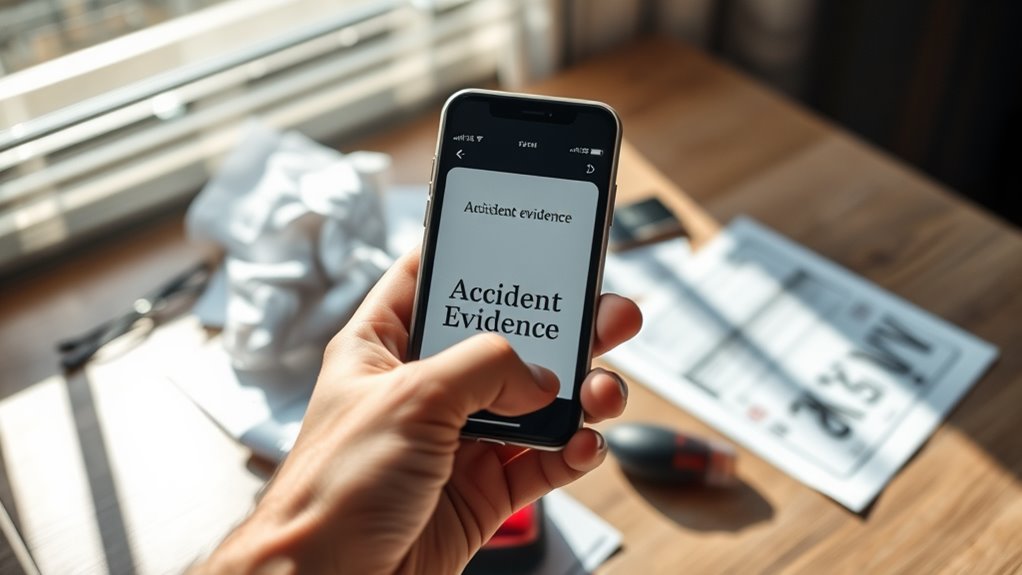When you find yourself in an accident involving an uninsured motorist, knowing the best steps to take can greatly impact your claim's outcome. It is important to prioritize safety first, but the following steps require careful attention to detail. From gathering essential evidence to negotiating your settlement, each stage plays an important role in ensuring you receive the compensation you're entitled to. Understanding these processes can be the difference between a successful claim and a frustrating experience.
Key Takeaways
- Ensure safety and call emergency services if necessary; document any injuries for future reference.
- Gather all relevant information, including the other driver's details and witness contact information.
- Notify your insurance company promptly, providing details of the accident and any police reports.
- Collect evidence such as photographs of the accident scene and medical records for your claim.
- File a formal claim with your insurer, including all necessary documentation and correspondence.
Ensure Safety and Seek Emergency Services

When you find yourself in an accident, guaranteeing safety and seeking emergency services is your immediate priority.
Start by checking for injuries among all parties involved. If anyone requires medical assistance, call emergency services right away. Move vehicles to a safe location if possible, reducing the risk of further incidents. Ascertain everyone stays safe before taking any other actions. Having affordable auto insurance can help cover medical expenses later.
Begin by assessing injuries and calling for help if needed, then ensure vehicles are moved to a safe area to prevent further danger.
Monitor health conditions closely, paying attention to visible injuries like cuts or fractures. If you're trained in first aid, administer care carefully. Keep individuals calm and still until help arrives, documenting any immediate health issues for later reference. Contact authorities immediately to request a police report at the scene, as this can be crucial for thorough reporting and obtaining necessary documentation.
Maintaining a secure environment is essential to prevent additional accidents and guarantee the well-being of everyone involved.
Gather Information and Document the Scene
An effective response to an accident requires promptly gathering information and documenting the scene to support your uninsured motorist claim.
Start by collecting vehicle details, including make, model, and license plate numbers for all parties involved. Identify all individuals present, including witnesses, and obtain their contact information. Document the time, date, location, and conditions surrounding the accident.
Be sure to take clear photographs of vehicle damages, road conditions, and any visible injuries, while also considering video footage if possible. Note environmental factors, such as weather and visibility.
Finally, obtain a police report, as it can serve as vital evidence of fault and accident details, ensuring you have a thorough record to strengthen your claim.
Notify Your Insurance Company
Notifying your insurance company as soon as possible after an accident is crucial for a smooth claims process.
Timeliness is key; delays can hinder your claim. Provide complete details, including the police report number, the other driver's information, and any witness statements.
Familiarize yourself with your policy's coverage limits and exclusions, as this knowledge sets realistic expectations.
Collaborate closely with claims adjusters, maintaining clear records of all communications.
Adhering to your policy's requirements, such as notification deadlines, is essential to avoid complications.
Clear and concise communication about the accident will accelerate processing.
Promptly responding to requests for additional documentation further aids in expediting your claim and guarantees compliance with necessary protocols.
Collect Relevant Evidence

To effectively support your uninsured motorist claim, collecting relevant evidence immediately after the accident is essential.
Start by obtaining the police report, as it serves as a vital official record. Document the date, time, location, and circumstances of the accident.
Collect detailed medical records and repair estimates for your vehicle. Take clear photographs of the accident scene, vehicle damage, and any injuries. Capture skid marks, debris, and traffic signs to establish context.
Don't forget to gather witness contact information and statements, as they can corroborate your account. Additionally, document the other driver's information and their uninsured status.
Keeping organized records will streamline the claim process and strengthen your position.
Submit a Formal Claim
With all relevant evidence in hand, you're ready to submit your formal claim to the insurance company.
Start by filing the claim officially, ensuring you include all necessary documentation, such as police reports, medical records, and witness statements.
Begin the claims process by officially filing, and remember to attach essential documents like police reports and medical records.
Review your insurance policy to understand its specific requirements and limits, as well as any deductibles that may apply.
Keep communication channels open with the insurer, as they'll likely assign an adjuster to manage your claim.
This initial interaction is essential for a smooth process, so clarify any policy details while submitting your claim.
Being thorough and proactive at this stage can help facilitate a timely investigation and assessment of your uninsured motorist claim.
Negotiate Your Settlement
While maneuvering through the complexities of an uninsured motorist claim, negotiating your settlement is an essential step that can greatly affect the compensation you receive.
Start by understanding your policy limits and documenting all interactions with the insurance company. Carefully review their initial settlement offer against your actual damages.
Gather extensive evidence, including medical records, repair estimates, and witness statements, to strengthen your case. Maintain a professional tone during negotiations and submit a detailed demand letter outlining your damages.
Be ready to counter low offers with evidence-based arguments and keep meticulous records of all communications. If necessary, consider mediation or arbitration as efficient alternatives to litigation for reaching a fair resolution.
Seek Legal Assistance if Necessary

Negotiating your settlement can be a challenging process, particularly when faced with the complexities of uninsured motorist claims. Seeking legal assistance might be essential to navigate these intricacies effectively.
An attorney can help prove liability, especially when insurance companies dispute your claim. They understand complex legal issues, such as subrogation claims from health insurers, and can strategize negotiations to maximize your compensation.
With experience in dealing with insurers, lawyers manage the necessary paperwork and communication, alleviating your burden. Additionally, they can identify potential pitfalls that may hinder your settlement.
Conclusion
In summary, filing an uninsured motorist claim can be a complex process, but following these steps can greatly improve your chances of a successful outcome. It's essential to gather thorough evidence and communicate effectively with your insurer. The theory that meticulous documentation and prompt action lead to better settlements holds true in practice. By approaching your claim with diligence and attention to detail, you not only streamline the process but also position yourself for a fair resolution.

